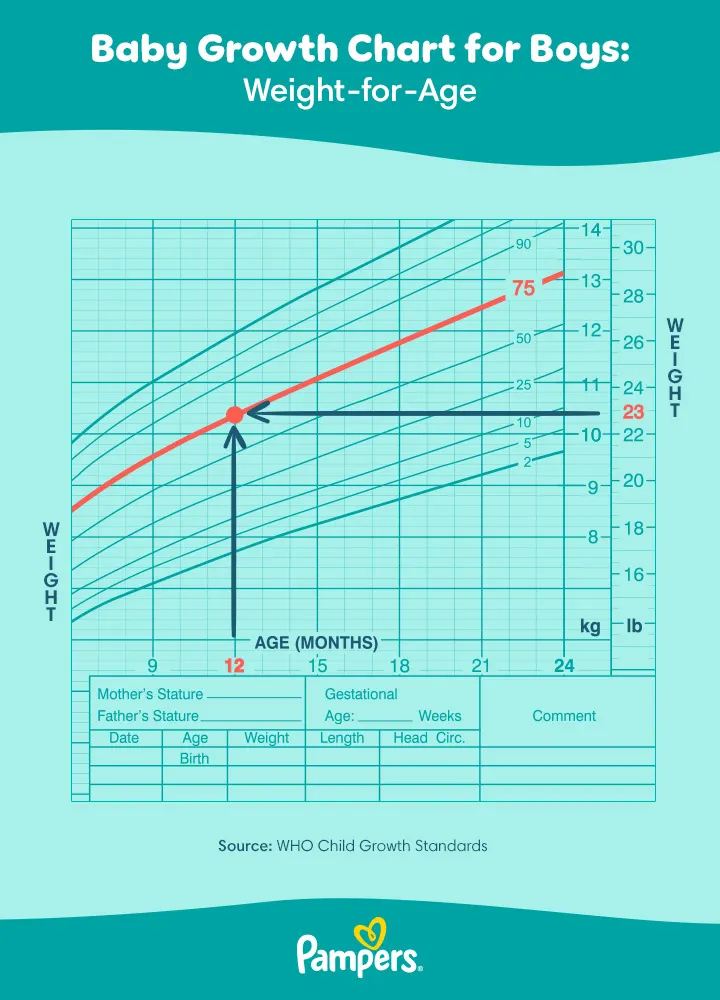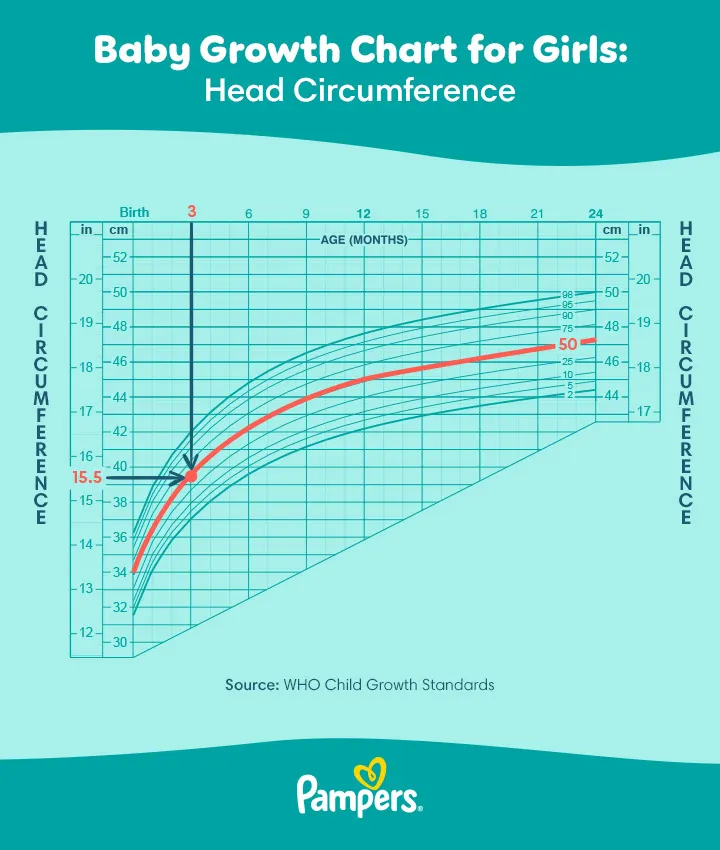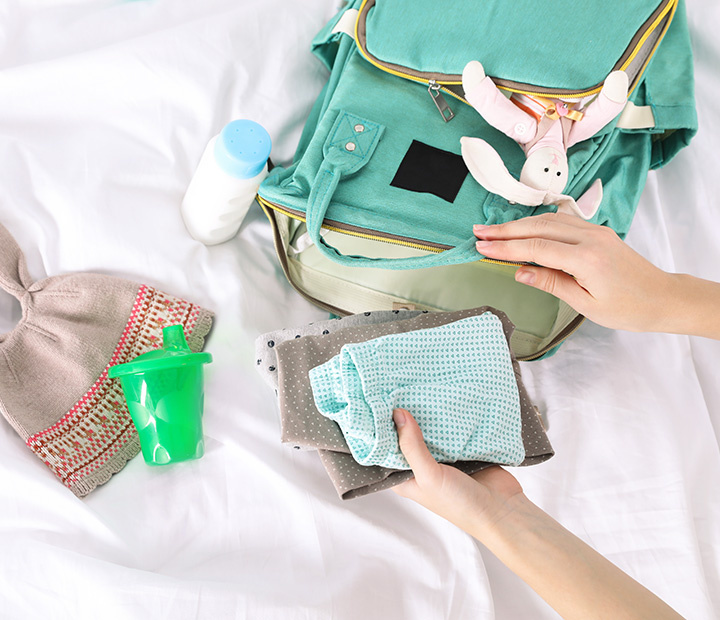How to Track Your Baby's Growth: A Guide to Understanding Growth Charts
Each baby develops uniquely, following their own individual pace and pattern. During routine checkups, your healthcare provider will use a baby growth chart to track your child’s progress. This tool helps monitor your little one’s development over time. While growth charts might seem overwhelming at first, they’re very helpful in understanding your baby’s growth pattern. In this article, we’ll walk you through how to read a baby growth chart and make sense of the results with ease.
How to Read a Baby Growth Chart
Once you have your baby’s measurements, looking at a baby growth chart can feel a bit confusing. Thankfully, your healthcare provider will walk you through how to interpret your child’s progress during each checkup. In the meantime, here's a simple guide to help you understand these charts. Keep in mind, that there are different charts for boys and girls, so it’s essential to use the baby boy growth chart for boys and the baby girl growth chart for girls.
Weight-for-Age Percentile
While the weight-for-age percentile chart may seem complicated at first glance, it’s quite straightforward once you know the steps. This chart helps you track your baby’s weight compared to other children of the same age. Here’s how to use it:
Find your baby’s weight (in pounds or kilograms) along the side of the grid.
Locate your child’s age in months
Draw imaginary lines from both points until they intersect on one of the curved lines.
Follow that curved line to the end, where the percentile is shown.
This percentile tells you how your baby’s weight compares to others their age. For instance, if your baby is in the 60th percentile, it means they weigh more than 60 percent of babies the same age, but less than 40 percent.
Tip In the example above, the child is a boy who is 12 months old and weighs between 10 to 11 kilograms. According to the baby weight growth chart, this baby is in the 75th weight percentile, meaning 75 percent of 1-year-old baby boys weigh less, and 25 percent weigh more. |
Length-for-Age Percentile
To determine your baby’s length-for-age percentile on the baby length chart, follow these steps:
Find your baby’s length (centimetres or in inches) along the side of the grid.
Locate your child’s age in months at the bottom.
Draw imaginary lines from both points until they meet on the growth curve.
Follow that curve to the end, where the percentile is listed.
Tip In the example above, the child is an 18-month-old girl who is 77cm long. As the growth chart indicates, this toddler is in the 10th length (height) percentile, meaning 10 percent of children her age are shorter, and 90 percent are longer (taller). |
Head Circumference Percentile
To find your baby’s head circumference percentile on the baby growth chart follow these steps:
Locate your baby’s age in months at the top of the chart. While not every month is numbered, each is represented by a vertical line.
Find your baby’s head circumference (in inches or centimetres) along the side of the chart.
Draw imaginary lines from both points until they meet on the curved line.
Follow the curve to the right, where you’ll find the percentile for your baby’s head size.
Tip In the example above, the child is a 3-month-old girl with a head circumference of a little over 39cm. As the growth chart indicates, this baby is in the 50th percentile, meaning half of all 3-month-old baby girls have bigger heads, and the other half have smaller heads. |
Weight-for-Length Percentile
To determine your baby’s weight-for-length percentile on the baby growth chart, follow these steps:
Find your baby’s length (in inches or centimetres) along the bottom of the chart.
Locate your baby’s weight (in pounds or kilograms) along the side.
Draw imaginary lines from both points until they meet on the growth curve.
Follow that curve to the right, where you’ll find your baby’s weight-for-length percentile.
This percentile helps assess how your baby’s weight compares to other children of the same length.
Tip In the example above, the child is a boy who weighs around 4.5 kilograms and is 53 cm long. According to the growth chart, this baby is in the 90th percentile, meaning 90 percent of baby boys this length (height) have a lower weight, and 10 percent have a higher weight. |
What Are Baby Growth Charts?
Baby growth charts are essential tools used by healthcare providers to monitor your baby’s overall health and development. These charts compare your baby’s growth to other children of the same age and sex, helping to track their progress over time. For babies under 24 months, growth charts typically include the following measurements:
Weight-for-age: Tracks your baby’s weight at a specific age.
Length-for-age: Measures your baby’s length (height) at a certain age.
Head circumference: Tracks the distance around the largest part of your baby’s head, which helps monitor brain growth.
Weight-for-length: Assess your baby’s weight with their length.
Healthcare providers use different growth charts based on your baby’s sex and age, including specialized charts for premature babies and children with Down Syndrome. The charts for babies under 24 months differ from those used for children 2 years and older.
In Summary Your baby’s healthcare provider will use baby growth charts (specific to sex and certain age ranges) to track your child’s development over time. These will include charts that display weight for age, length (height) for age, head circumference, and weight along with length (height). |
These charts provide valuable insights that your little one’s healthcare provider can evaluate alongside other baby developmental milestones and genetic factors. You can find and download the growth charts below.
Baby Boys Growth Chart: Birth to 24 Months
Baby Girls Growth Chart: Birth to 24 Months
When and How Is Your Baby Measured?
You likely chose your baby’s healthcare provider during pregnancy, and your little one’s first checkup will be within a few days of birth or shortly after leaving the hospital.
Starting with this initial visit, monitoring your baby’s growth becomes a routine part of every checkup, whether they’re 1 month old or 1 year old.
Early on, your baby’s checkups will occur every few weeks, gradually spacing out to every few months as your baby approaches their first birthday. Their healthcare provider will guide you on how frequently you’ll need to visit and when to schedule future appointments. Feel free to ask any questions you may have about your baby’s health and development—your child’s healthcare provider is your partner and can reassure you that you’re doing a great job and help you resolve any issues that pop up!
Here’s how babies are usually weighed and measured:
Weight: To get the most accurate reading, your provider will weigh your baby undressed using a baby scale.
Length: Measuring a wiggly baby can be tricky, but your provider is experienced with this! Your baby will lie on a flat table, and the provider will gently stretch out their legs to measure from the top of their head to the soles of their feet.
Head circumference: A soft tape measure will be wrapped around the widest part of your baby’s head, passing above the eyebrows and ears to the back of the head, ensuring an accurate measurement.
In Summary At each health checkup, your baby’s provider will weigh your baby using a baby scale, measure their length from head to toe, and check their head circumference to monitor brain growth. |
Wondering what to expect at your baby’s regular health checkups? These links will help you prepare for your little one’s first few visits, and provide information on upcoming immunizations:
You can also use our baby milestones tool to track your baby’s development!
How to Interpret Baby Growth Chart Percentiles
Your child’s healthcare provider is the best resource to help you understand your baby’s growth chart results. These charts display typical growth patterns for both baby boys and girls, but it’s important to remember that there’s a wide range of health outcomes. Instead of focusing on any one percentile, the key is to watch how your baby follows their growth pattern over time. Ideally, your child’s weight and height should grow proportionally, whether they’re in the 10th percentile or the 90th percentile.
What Are the Percentiles?
The growth chart for babies helps you see which percentile your child falls into compared with others of the same age and sex. Percentiles are represented as curved lines.
Here’s an example to explain how they work:
If your baby is in the 70th percentile for length-for-age, it means:
Seventy percent of babies the same age and sex are shorter than your baby.
The remaining 30 percent of babies the same age and sex are longer than your baby.
But, this one point doesn't show the complete picture. Your child’s provider will assess several values over time to determine the trend of how your baby is growing compared to the average growth curve on the chart.
Try not to become too focused on a single number. There is a wide range of healthy sizes and lengths, and many factors influence your child’s growth, including genetics, environmental factors, nutrition, activity levels, and health conditions.
Another thing to consider is when babies have growth spurts, which can vary from child to child. For example, breastfed and formula-fed babies grow in slightly different patterns. Breastfed babies typically put on weight more slowly than formula-fed babies and formula-fed infants typically go through a growth spurt and gain weight more quickly after 3 months of age.
Tip As your baby grows, the diaper size will change, too. Take a look at our diaper size and weight chart to make sure that your baby’s diaper fits comfortably and has no leaks or blowouts. And, take the quiz below to make sure your baby has the perfect size! |
What Happens if My Baby’s Growth Pattern Changes?
A different growth pattern doesn’t necessarily signal a problem. It could simply be due to a growth spurt, which is why it’s essential to monitor these percentiles over time. However, your child’s healthcare provider will also investigate a growth pattern change to rule out any issues. Typically, a healthy, well-nourished baby grows at a fairly predictable rate. Any change in this rate can help your baby’s provider detect and address feeding, developmental, or medical concerns.
What Happens if My Baby Is Above or Below the Average?
Most babies fall between the 3rd and 97th percentiles on baby growth charts for head circumference, weight, and length. However, if your baby doesn’t, remember that many factors, such as genetics and other developmental milestones, are taken into consideration by your healthcare provider.
Baby growth chart percentiles aren’t like an algebra exam. Just because your little one is in the 50th percentile doesn’t mean there’s a problem! That figure means your baby is right in the middle of the average. What’s more important is how your child grows over time. Plus, some families might have fast-growing babies, while others have slowed and steady gainers.
Regardless of what you see on your baby’s growth chart, try not to worry, and keep these individual differences in mind as you follow your child's development. If the healthcare provider determines that your baby is overweight, underweight, growing too fast, or growing too slowly, trust that your little one is in good care, and follow the provider’s recommendations.
FAQS AT A GLANCE
A baby growth chart tracks four standard measurements as your child grows and develops. They include weight-for-age, length-for-age, head circumference, and weight-for-length. You can plot your baby’s measurements on a growth chart to determine the percentile.
The Bottom Line
Baby growth charts, whether for boys or girls, can be confusing at first glance. In the end, it’s always best to look at your baby’s growth chart percentiles together with their healthcare provider over time and to avoid comparing your child to others.
Instead, focus on all the growing your little one is doing! And, if your baby’s healthcare provider says they’re on the right track, you can take pride in your child’s progress regardless of the value on the chart. You’ll probably be delighted (and maybe even a little surprised) when you see how big your baby is now compared to the day they were born.
Your little one is a moving, grooving, and growing machine, and there’s so much to look forward to, such as watching them start to crawl and walk, hearing those first laughs, and helping them develop those fine motor skills.
As your baby hits milestone after milestone, reward yourself for all your hard work with our Pampers Club App.
How we wrote this article
The information in this article is based on the expert advice found in trusted medical and government sources, such as the American Academy of Pediatrics and the American College of Obstetricians and Gynecologists.
The content on this page should not replace professional medical advice. Always consult medical professionals for full diagnosis and treatment.
Join Pampers Club and get:










